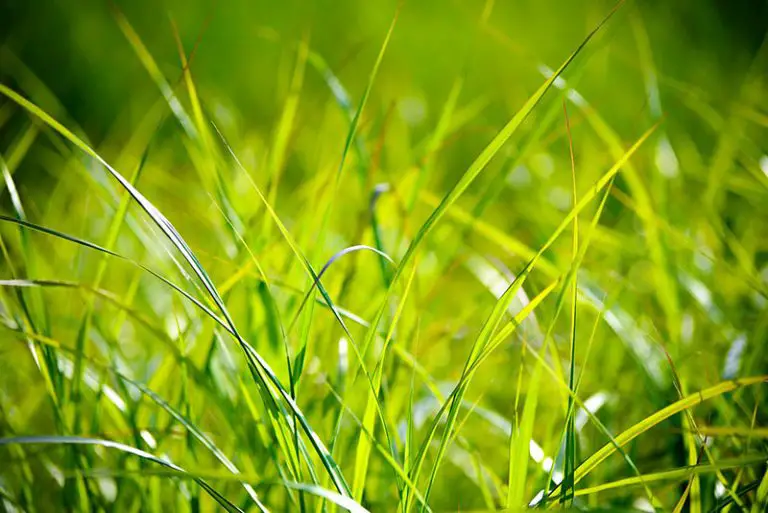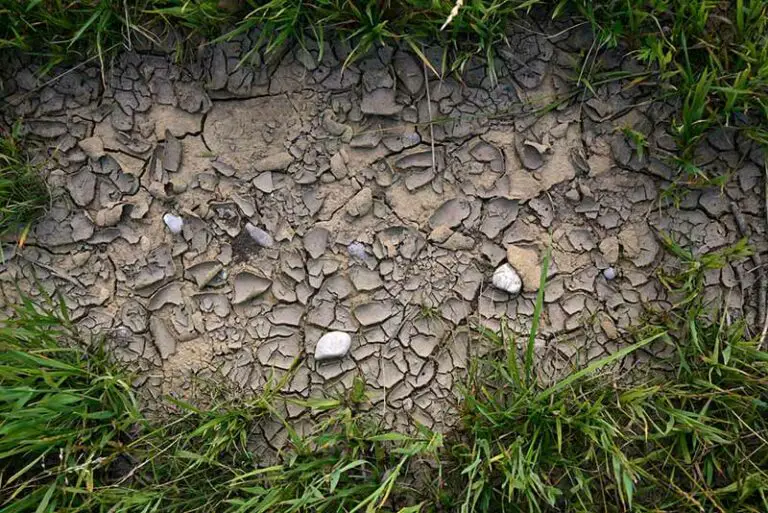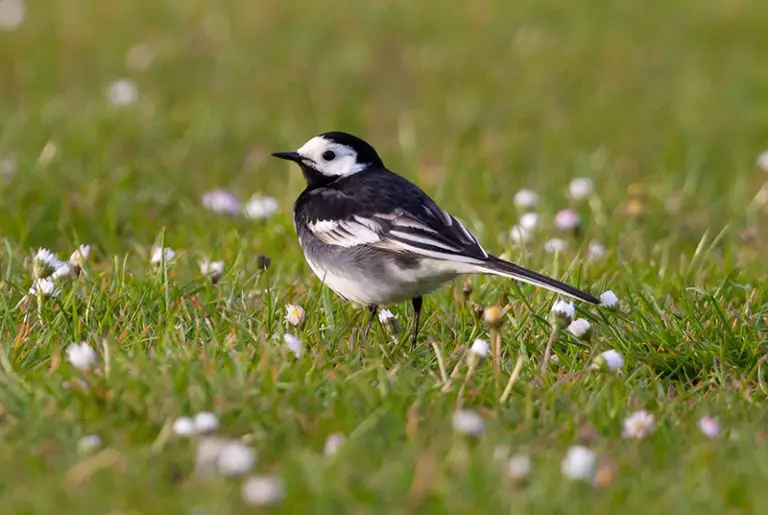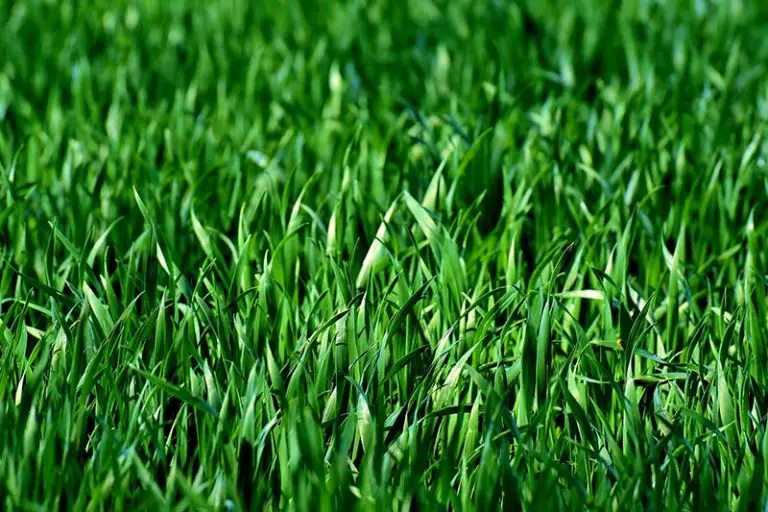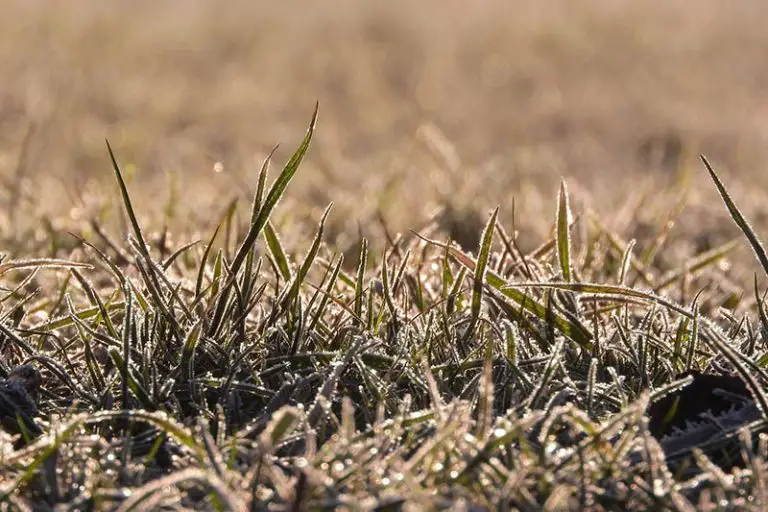How Long Does Grass Seed Take to Grow?
There are a number of different factors that can have an impact on how long it takes for grass seed to germinate and grow into full green blades. Different types of grass will germinate at different rates, and this rate can also be affected by external conditions such as the weather, time of year and level of moisture in the soil.
As a general idea, grass seed germination can take between 5 and 30 days, sometimes even longer than this in cooler temperatures. When they have finished germinating, your sprouts will start growing at a rate of roughly 2-3cm per week, and should become a fully established lawn in around 6-8 weeks.
Grass Seed Germination Time by Species
One of the most important factors that you need to take into consideration when purchasing your grass seed is whether the species is a cool-season grass or a warm-season grass. Cool-season grasses will thrive in cooler climates such as those found in the north, whereas warm-season grasses prefer the warmth of the south, so you should make sure to get the best seed species for the climate in your area.
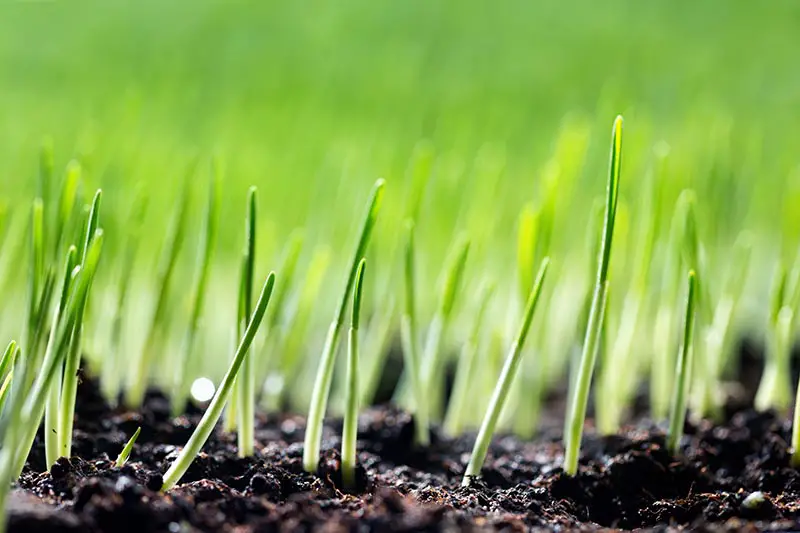
Cool-Season Grass Germination Times
Cool-season grasses are the fastest type of grass to grow from seed and thrive in a cooler, more northern climate. The ideal temperature for the fast germination of these seeds is to grow them in soils of between 50 and 65°F, having an air temperature of between 60 and 75°F. Under optimal conditions with proper care, all cool season grass seeds have the ability to grow from seed to lawn in 30 days.
| Cool-Season Species | Germination Time |
| Annual or Perennial Ryegrass | 5 – 10 days |
| Kentucky Bluegrass | 7 – 10 days |
| Tall Fescue | 7 – 12 days |
| Hard Fescue | 7 – 14 days |
| Bentgrass | 10 – 14 days |
| Red Fescue | 12 – 22 days |
You should plant cool-season grasses during a time of year when temperatures are cool and are expected to stay low for the next few months so your new grass seedlings have the chance to establish themselves before the weather gets too warm. For most people, this means planting cool season grass seed in summer, fall, or possibly late winter, but some may be able to do this in spring depending on the climate in your area.
Warm-Season Grass Germination Times
Warm-season grasses grow at a slower rate than cool-season grasses, as they have a longer germination time and take longer to develop their roots. They prefer a warmer climate and tend to be grown in the south. To grow at their fastest rate of germination, warm season grasses need to be in soil that’s at a temperature of between 60 and 75°F, and daytime temperatures at a constant of 80°F. If the weather conditions cause the soil temperature to drop, this will impede the germination process and can potentially kill off young grass seedlings. After the first two months of seeding, warm-season grasses may grow tall enough to be mowed, however, it could take up to a year to see the full establishment of your lawn.
| Warm Season Grass Species | Germination Time |
| Seashore Paspalum | 7 – 14 days |
| Bermuda Grass | 10 – 30 days |
| Centipede Grass | 14 – 21 days |
| Zoysia Grass | 14 – 21 days |
| Bahiagrass | 14 – 28 days |
| Buffalo Grass | 14 – 30 days |
Warm-season grasses will do best when planted in late spring or early summer. Remember that they’ll take a longer time to germinate, and this process can be disrupted by sudden cold temperatures. Aim to plant your warm season grass seed early enough in the year so that it will be well established before the first frost comes in fall.
Other Factors that Affect Grass Seed Germination
Preparation of the Soil
Preparing the soil is key before putting down any grass seed, regardless of whether you’re reseeding an existing lawn or growing a new lawn from scratch. You should kill any weeds in the planting area using weed killer, and then take note of how long to wait between applying your chosen weed killer and planting new grass seed.
At this stage, it’s also highly recommended that you carry out a soil pH test to find out the soil pH, as well as the levels of nutrients currently present in the soil – you can easily purchase an at-home kit like this Luster Leaf Rapitest Soil Test Kit to find this out. Based on the results, make any necessary adjustments by applying a pH-altering material or fertilizing the lawn, ideally with an organic fertilizer.
Another tip is to spread 1 to 2 inches of compost throughout the planting area and till it into the topmost inch of the soil in order to provide the seedlings with a hospitable root zone; grass seed grows in compost very well due to the nutrients it contains. Rake the area and remove any rocks and debris to create a smooth seedbed. Directly after sowing the new grass seed, cover the area with a fine layer of straw, which acts as an organic mulch. Avoid stepping or placing anything on the area until you mow the new grass for the first time.
How the Seed is Sown
New grass seed needs to be properly sown into well-prepared soil to give it the best environment possible for growth. After carrying out the necessary preparatory activities such as those outlined in the previous section, you can sow your new grass seed. It is possible to do this by hand, but ideally, this should be done using a seed spreader to distribute the grass seed evenly throughout the planting area. The Scotts Turf Builder EdgeGuard Mini Broadcast Spreader will be ideal for most lawns.
Immediately after sowing, rake the planting area to further ensure the even distribution and incorporation of the seed into the soil. Finally, compact the planting area back down using either your foot or a lawn roller, as this will improve seed to soil contact which increases the likelihood of fast germination.
Moisture of the Soil
Another crucial factor in growing new grass is making sure the soil consistently retains the optimal level of moisture throughout the growing process. Underwatering your soil and allowing it to become dry will also cause your seeds to dry out, while overwatering can interrupt germination and obstruct new seedlings from getting oxygen from the soil. Excessively watering newly sown seeds won’t speed up the growing process at all, and may also wash the seeds away entirely.
As a general guide to how often you should water new grass seed, aim to water the planting area daily from the day of sowing until the seedlings have fully germinated. Once germination is complete, you should continue to make sure the top layer of the soil is consistently moist to encourage deep root development. Over the following weeks, you can begin a regular watering schedule by gradually reducing the frequency of watering while increasing the length of time that you water each time.
Amount of Sunlight
Your lawn will grow best if it has access to full direct sunlight. After your young grass seedlings have finished germinating, you will start to see their green sprouts emerging from the soil. The seedlings need sunlight in order to grow long deep roots and thick blades, and they use their newly grown green sprouts to absorb this light.
With enough sunlight, grass seed will grow thick and fast, but without it, the seedlings will grow sparsely and you may end up with a patchy lawn. You should make sure that the planting area into which you plan to sow the seed receives a minimum of six hours of direct sunlight a day. You also have the option of sowing a ‘shade seed mix’ if there’s no possible way to get direct sunlight to the planting area – our top recommendation is this Turf Builder Grass Seed Dense Shade Mix from Scotts, as the tolerant seed is able to grow in areas that see as little as 3 hours of sunlight a day.
Age & Storage of Grass Seed
The age of your grass seed and the conditions in which it was stored will affect how quickly it germinates. Grass seed is notoriously resilient, lasting in storage for anywhere from 2 to 10 years, however, this length of time is heavily dependent on the conditions in which the grass seed is stored. Even under optimal conditions, the germination rate of the grass seed will drop by around 10 percent for each year that it’s in storage.
The best way to store unused grass seed for later use is to keep it in a humidity-free, cool, dark space, and preferably to place it into a sealed container as opposed to leaving it in the bag, as bagged seed is far more vulnerable to the negative effects of humidity. If you’re seeding with grass seed that has been in storage for a while, you may have to apply a greater quantity to see the same results as you would with fresh grass seed. See our article Does Grass Seed Go Bad for more information on how to properly store leftover seed.
Quality of Grass Seed
The way in which grass seed is harvested directly affects the germination rate of the seed, with higher quality seeds germinating more quickly than lower quality seeds. Grass seed purchased from a garden store will come with a ‘tested date’ in addition to a germination rate, which is usually measured at 80 percent or more – this is the rate that your grass seed will likely germinate at if sown within the first year of the packaging date and grown in optimal conditions. In addition to this, store-bought grass seed packets are made up of a mixture of different seeds which will likely be of varying quality, meaning that some of your seedlings will take longer to germinate and sprout than others.
Mistakes to Avoid When Growing Grass Seed
Choosing the Wrong Type of Grass Seed
Make sure that you pick the correct type of grass seed for the climate of the area that you live in. As we’ve explained, cool-season grasses prefer cooler climates such as those in the north, while warm-season grasses do better in warmer southern climates. The United States is divided into planting zones, so do some research and find out what planting zone you’re in before purchasing the grass seed to ensure you pick a species that will thrive in your area’s climate.
Planting Grass Seed at the Wrong Time of Year
After you have picked the right grass seed for your climate, you should then take into consideration the time of year which you plan on sowing the seed. Cool-season grasses should be planted when temperatures are expected to be low for the next few months, meaning the seedlings have the chance to be fully germinated and established before temperatures warm up. On the other hand, warm-season grasses should be planted in spring or early summer to give them a chance to establish themselves before the first frost in fall. All grasses turn dormant and stop growing over winter, as explained in our article When Does Grass Stop Growing.
Overwatering or Underwatering the Planting Area
Both overwatering and underwatering the planting area can inhibit the growth of your newly sown grass seed. Grass seed requires different amounts of water depending on what stage of the growth process it’s at, but as a general idea, you should aim to keep the top few inches of soil consistently moist at all times during the early stages of germination. As your seedlings progress through the different stages of growth, you should gradually decrease the frequency of watering but increase the quantity of water that you apply each time.
Ignoring Seeding Rates
The seeding rate, which is the number of seeds you should put down per square feet, varies depending on what type of grass seed you have chosen. It may seem to make logical sense that applying more seeds will result in more grass on your lawn, however, this isn’t the case. Using more seeds than the amount recommended on the packaging means that the growing seedlings will have to fight each other for the water and nutrients available in the soil, which may slow down the growing process and can prevent some seedlings from growing at all.


